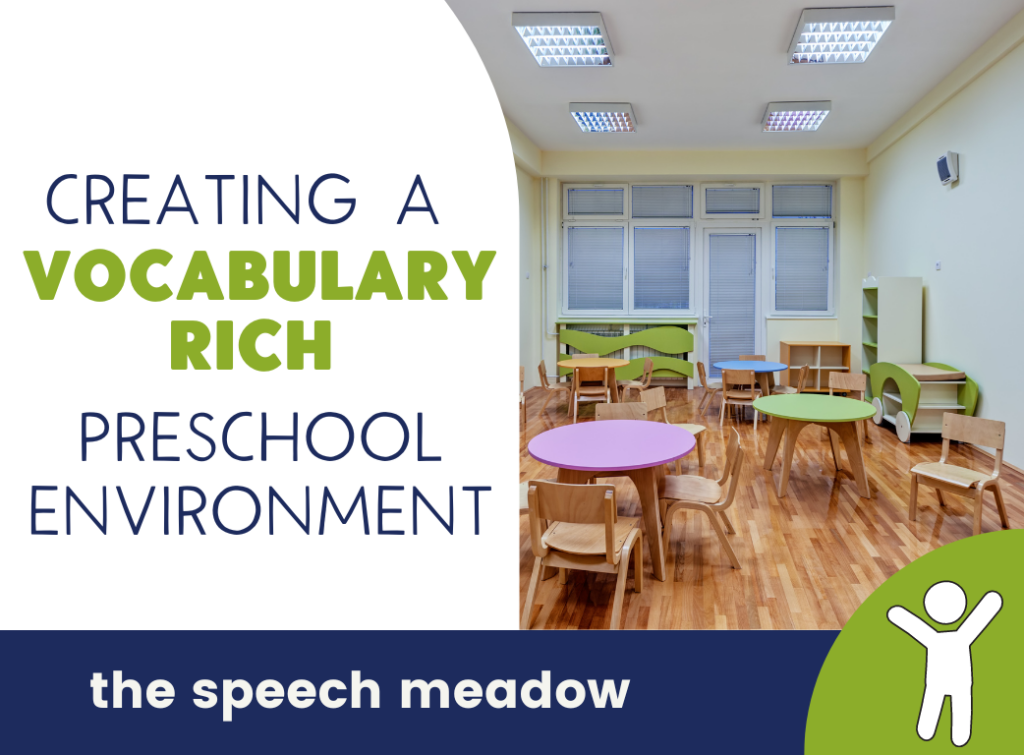Establishing an environment for vocabulary development is crucial for all children. This is especially true for children who are in special education/at-risk programs. In my experience, most of these children have weak vocabularies. They need to be exposed to a variety of words, not just nouns, over and over and over again. Here are five tips I have found helpful for creating vocabulary rich preschool classrooms.

Use themes
This is a great way make sure that children are exposed to same/similar vocabulary during the time you are working on a theme. They would be exposed to words such as farm animals during circle time, while reading books, while playing, etc… Some children may be playing with cause and effect toys. It can be challenging, but try and find some cause and effect toys that match the theme. For a list of favourite topics, click here.
Even with emergent curriculum* being implemented here in Alberta, I would argue that you can still do an overarching theme. If you have children who love vehicles, have them use toy farm equipment. If you have children who love blocks, have them stack “hay bales.” Finally, if you have a theme that the children are loving, then don’t be afraid to extend that theme for a week or two. As well, if your children really are not interested in a specific theme, then don’t be afraid to cut that theme short.
Be intentional about the toys/equipment you use.
If you are using themes, this can be easier. If you are doing a farm theme, then every centre and free-play area is related to farms and farming. For example, use counting pigs to work on math skills. Create a mud table and put animals in it for sensory play. Same goes for circle time. If you are not using themes, then think about the vocabulary you want the children to learn and brainstorm about activities that would best teach that vocabulary.
Pick specific vocabulary to focus on
Write down a list of vocabulary that you want to target in class. It is also helpful to post the words somewhere in the classroom. I have even seen it where they post the words, where they would be most frequently used (e.g., clean and dirty were displayed above the water table). Make sure that you are picking more than just labels for things. Children need to be exposed to a wide variety of vocabulary including action words, location words and describing words.
If you are working with a Speech-Language Pathologist (SLP), find out what vocabulary goals the children have and incorporate them into your classroom. E.g., if you have children working on “in” and “out,” talk about the pigs going “in” the mud to get dirty and coming “out” of the mud to get clean. At the same time, share with your SLP/OT/PT your themes. They could probably find activities to work on their goals using your theme regardless if they are doing pushed in or pull out therapy. For more ideas on developing prepositions, click here.
Play and interact with the children
This may seem obvious to some people and very challenging for others. First off preschool sizes are getting larger and even with a “large” number of adults, staff members are often busy with crowd control, or paperwork, or getting ready for the next part of the schedule. Secondly, many adults have forgotten how to play or feel uncomfortable getting down and playing with children.
Remember, you are helping to expose children to a vast array of vocabulary and knowledge. Playing with allows you to answer their questions and expand their understanding. Children are little sponges and will learn from each other. If you teach a few, then they will often then teach some of the other children.
Make it fun
The more fun you have and the children have, the quicker they will learn, the longer they will retain it, and the odds are they will go home and share it with their families.
For other preschool push-in therapy posts, go here. With the vast array of studies linking vocabulary size and use to academic success, it is vital for preschool classrooms to be as rich in vocabulary as it can.
*A very concise definition of emergent curriculum is a process where the classroom staff uses the students’ interests, skills levels, and needs in order to plan the activities in the classroom.

One Comment